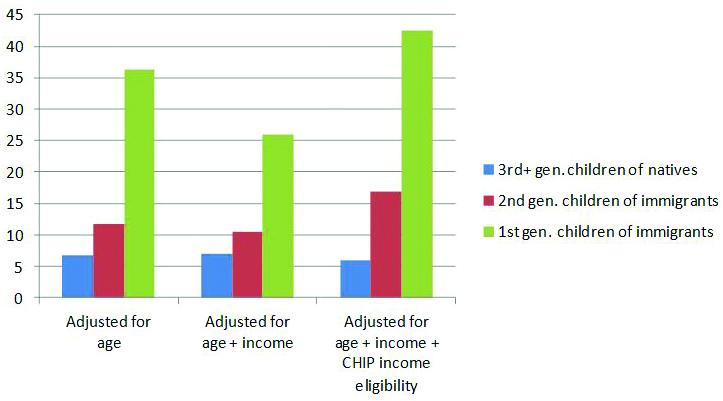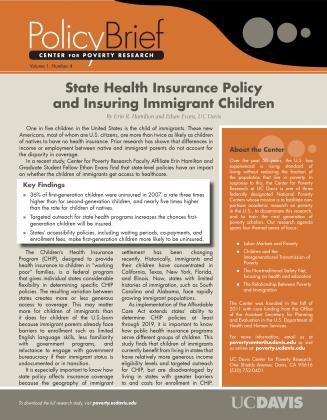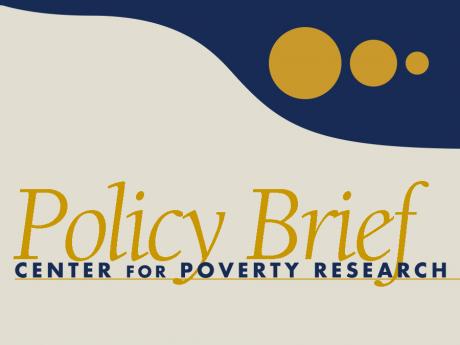State Health Insurance Policy and Insuring Immigrant Children
By Erin R. Hamilton and Ethan Evans, UC Davis
One in five children in the United States is the child of immigrants. These new Americans, most of whom are U.S. citizens, are more than twice as likely as children of natives to have no health insurance. Prior research has shown that differences in income or employment between native and immigrant parents do not account for the disparity in coverage.
In a recent study, Center for Poverty Research Faculty Affiliate Erin Hamilton and Graduate Student Fellow Ethan Evans find that state-level policies have an impact on whether the children of immigrants get access to healthcare.
Key Findings
- 36% of first-generation children were uninsured in 2007, a rate three times higher than for second-generation children, and nearly five times higher than the rate for children of natives.
- Targeted outreach for state health programs increases the chances first-generation children will be insured.
- States’ accessibility policies, including waiting periods, co-payments, and enrollment fees, make first-generation children more likely to be uninsured.
The Children’s Health Insurance Program (CHIP), designed to provide health insurance to children in “working poor” families, is a federal program that gives individual states considerable flexibility in determining specific CHIP policies. The resulting variation between states creates more or less generous access to coverage.
This may matter more for children of immigrants than it does for children of the U.S.-born because immigrant parents already face barriers to enrollment such as limited English language skills, less familiarity with government programs, and reluctance to engage with government bureaucracy if their immigrant status is undocumented or in transition.
It is especially important to know how state policy affects insurance coverage because the geography of immigrant recently. Historically, immigrants and their children have concentrated in California, Texas, New York, Florida, and Illinois. Now, states with limited histories of immigration, such as South Carolina and Alabama, face rapidly growing immigrant populations.
As implementation of the Affordable Care Act extends states’ ability to determine CHIP policies at least through 2019, it is important to know how public health insurance programs serve different groups of children.
This study finds that children of immigrants currently benefit from living in states that have relatively more generous income eligibility levels and targeted outreach for CHIP, but are disadvantaged by living in states with greater barriers to and costs for enrollment in CHIP.
Estimating Disparities
This study links nationally representative data on children’s
health insurance coverage from the 2007 National Survey of
Children’s Health to state CHIP policies based in age group and
household income that apply in the child’s state of residence.
Researchers extracted CHIP policies from annual state reports
filed with the Center for Medicare and Medicaid Services.
The researchers then estimated how the disparity in insurance coverage between children of immigrants and children of natives was affected by differences in the income eligibility cutoffs across state CHIP programs, as well as by differences in CHIP policies affecting outreach, barriers to, or costs of CHIP participation.
Income and Eligibility Levels
Figure 1 shows the percentage of children who were uninsured in
2007 by immigrant status, differentiating between foreign-born
children of immigrants (first-generation Americans), U.S.-born
children of immigrants (second-generation Americans), and
U.S.-born children of native parents (third-and-higher-generation
Americans). Thirty-six percent of first-generation children were
uninsured in 2007, a rate that is three times higher than the
rate for second-generation children and nearly five times higher
than the rate for children of natives.
Part of this disparity reflects lower incomes among immigrant households, and that children in poor households are more likely to be uninsured. The second set of bars in Figure 1 details the fractions of uninsured children adjusted for income differences. This shows that eliminating income differences across first-, second- and third- or higher generation children would reduce but not eliminate disparities.
The study next considers how features of CHIP state-level policies contribute to differences in coverage. Children of immigrants, given their disproportionate location in particular states, are exposed to slightly more generous state CHIP eligibility levels than children of natives. First-generation children live in states that have an average eligibility level of 227 percent of the federal poverty level (FPL) and second-generation children an average of 231 percent of the FPL, compared to 220 percent of the FPL for children of natives.
States with the highest recent growth in the percentage of foreign born residents (South Carolina, Alabama, Tennessee, Delaware, and Arkansas) have substantially lower eligibility levels on average for all groups of children. Thus, without changes in state policies, and given that children of immigrants are poorer than children of natives, as more immigrants head to new destination states the disparity between children of immigrants and native born children may grow.
The final set of bars in Figure 1 shows that adjusting for state-level differences in the CHIP income eligibility levels has a clear effect on disparities in insurance status. If children of immigrants were exposed to the same state CHIP income eligibility levels as children of natives, 42 percent of first generation children and 17 percent of second generation children would be uninsured, compared to six percent of children of natives; these disparities are greater than what is actually observed, and much greater than we would expect controlling for income differences alone.
Accessibility Policies Make a
Difference
The study also examines state-level CHIP accessibility policies,
which include targeted outreach, waiting periods and co-payments.
Because these policies are only relevant to the insurance
coverage of eligible children, the study limits this part of the
analysis to children who are eligible based on household income,
age group, and their state’s CHIP income eligibility level.
None of the CHIP accessibility policies are significantly associated with insurance status for children of natives, but they are for children of immigrants. Children of immigrants benefit from living in states with targeted CHIP outreach. By contrast, children of immigrants are disadvantaged by living in states with enrollment fees, waiting periods, assets tests, and co-payments. Accounting for these policy effects would reduce the disparity between the 1st and 3rd generations by half and by two-thirds between the 2nd and 3rd generations.














